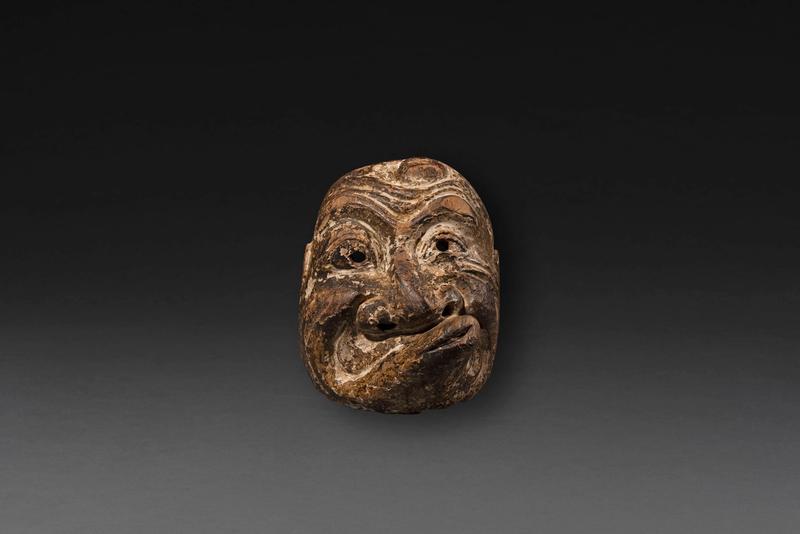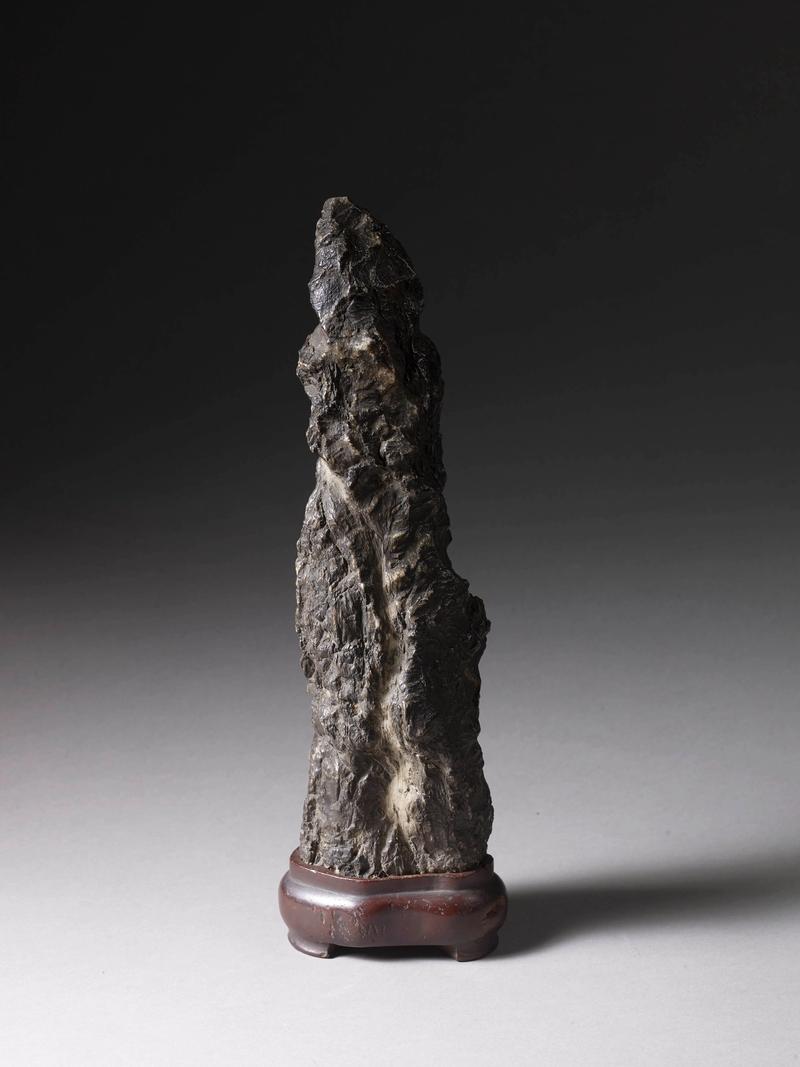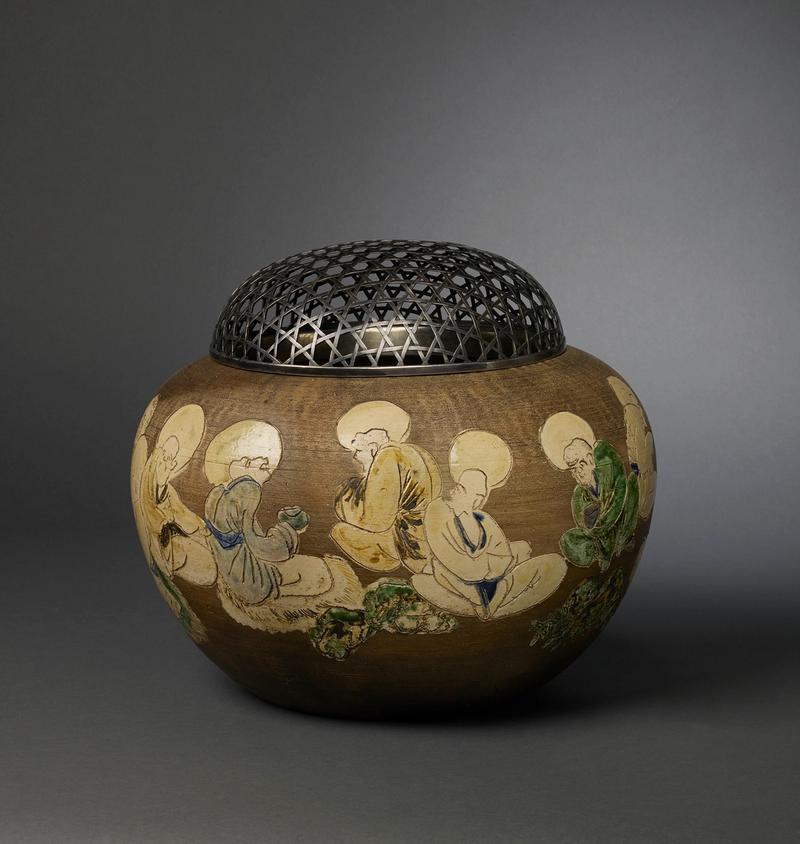A ceramic te-aburi (hand warmer) with a reticulated silver cover by Aoki Mokubei (1767-1833).
The body is decorated with seventeen Rakan (saintly ascetics) incised and painted in coloured enamels. All are seated wearing loosely fitting robes, a halo surrounds each of their shaved heads and some hold alms bowls whilst a few rest on straw mats.
Signed: Bunsei Kanoetora* shugetsu Rōbei zō. (Made by Rōbei during an autumn month in the year 1830 of the Bunsei period)
Seals:
Right, upper: undeciphered
Left, lower: Mokubei stamped upside down
Japan, 19th century, Edo period *1830.
Awasebako (fitted box) inscribed:
Lid: Te-aburi (hand warmer)
Label on box lid: Mokubei zo. Jyūroku rakan bori tsubo. Ryōro. Yonju yon go (Made by Mokubei. A hand warmer carved with the design of The Sixteen Rakan. Number 44)
Lid interior: Jyūroku rakan te-aburi. Genjū Kyokuken Zuidai, kiyo Aoki Mokubei jisaku Jokoan jūbutsu (Sixteen Rakan hand warmer. This piece, made by Aoki Mokubei, was donated to the Jokoin Temple. Written by the current abbot Kyokuken Zuidai.
Accompanying paper notes:
Envelope: Mokubei tesube kanteisho zaichu (Authentication of the work by Mokubei enclosed)
Inner envelope slip: Yonjyū yongo, Miyagawa o hansho tomoni nitsu, kanteisho, copy (A copy of the two-sheet authentication number 44, written by Miyagawa Kōsai potter).
The original authentication is also included.
Accompanying note 1st page: Akashi. Ichi Rakuyaki tetsubachigata teaburi. Migi, Mokubei o ga jyūrokurakan chokokuni saishiki wo kuwae, yoni marenaru toki seisaku. Shoshin machigainakiya. Meiji yojyūyo nen ***gatsu. Toshi Miyagawa Kōsai. (Authentication. One Rakuyaki style hand warmer in the shape of an iron bowl. Made by the old man Mokubei with a Sixteen Rakan carved design and painted in colour. This is a rare piece of pottery and undoubtedly an authentic work by Mokubei. Date: Meiji 41 (1908), Potter Miyagawa Kōsai)
Seals:
Right, upper: Part of the seal Jussui Goseki; a seal used by the Miyagawa Kōsai kiln
Left, lower seal: Miyagawa Zen’ō
2nd page: Mokubei o saku. Rakan ga tetsubachi-gata te-aburi. Kore Raku-yaki to shite o ga ginou wo yo ni shimesaru mono nari toho no giichi to shite nasazarunaki o wa kotsudatsu share tenpu no saino wo Rakuyaki no togi ni oyo shitarumono. O no tagi kyotan no hoka nashi. Keishiki yoku totonoi juuroku-rakan no gaho keimyi ni shite in ari, shikashite takumini shikisai wo hodokoshi-taraba giryo mata fujo Rakuyaki no oyobasaru tokoro nari. Kore Bunsei Kanoe-tora to areba Bunsei no matsunen Tenpo to kaigen arishi toshi nari. O bannen no saku nari. Hako ni Jokoin jubutsu to ari. Kore o ga Joko-in no tame ni tsukuri taruya mata yojinga Joko-in e zorashiki no meihin nari. Joko-in wa Kennin-zenji tattoo matsuji nari. Dated: Meiji 41st year. Miyagawa Kosaij jutsu, with seal Miyagawa Kosai. Arisawa Chuhei ki with seal Chuhei.
(Made by the old man Mokubei, a hand warmer in the shape of an iron bowl with the design of Sixteen Rakan. This is Raku ware made by Mokubei to demonstrate his exceptional pottery skills. He has achieved the utmost technical supremacy and his character, wit and ingenuity are exceptional, applying his pottery skills in this example of Raku ware. His tremendously versatile technical skill is really astounding; the shape of this work is extremely fine, and the drawing and colouring of the Sixteen Rakan is light and elegant. This work dates from the year of Kanoe tora, which is the last year of the Bunsei era and the first year of the Tempo era. Therefore, the work dates from later in his working life. The hakogaki inscription says it is a treasure at the Jokoin Temple, which might mean that either Mokubei made this work for the Temple or it was donated by the artist to the Temple. Such a fine work. The Jokoin Temple is one of the sub-temples attached to the Ken’nin-ji Zen Temple (Kyoto). Inscribed by: Miyagawa Kōsai.
Seals:
Left, lower: Miyagawa Kōsai (1845-1922) and Arisawa Chūhei (dates unknown).
Works of Art

A wood Noh mask of Koomote

A bronze flower vessel

A kakebotoke

A ceramic te-aburi (hand warmer)

A wood Kyōgen mask of Usobuki

A suiseki (viewing stone) of vertical form with a natural striation resembling a waterfall, with wood stand

A Chinese bronze censer

A Tokoname storage jar

A ceramic vase by Makuzu Kōzan II

A Chinese Suiseki (viewing stone)

A bronze flower vessel of mimikuchi

A pottery kake hanaire (hanging flower vessel)

A red lacquer Kamakura-bori dai-kogo (incense box)

A Lacquered Shield

A bronze brazier

A bronze hanging flower vessel

A black lacquer bon (tray)

A bronze brazier

An iron nyoi

A Tokoname storage jar













